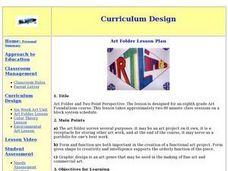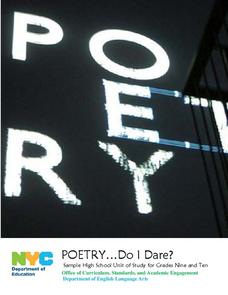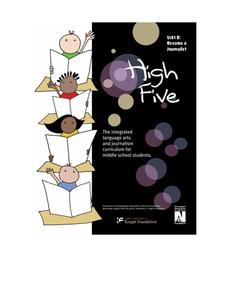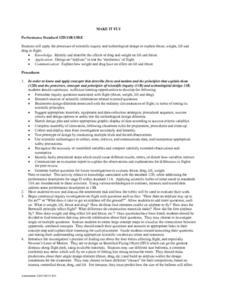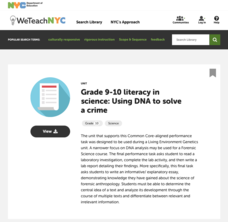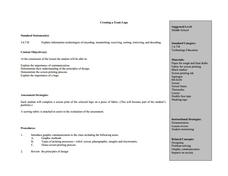Curated OER
Art Folder and Two Point Perspective
Eighth graders examine how to create a 3-D effect on a flat surface and draw in two-point perspective. They view and discuss elements of design, analyze artwork by M.C. Escher and Roy Lichtenstein, and design and create an art folder.
Curated OER
Technology: Programming Graphics
Students use the DrScheme program to create graphics for clip art. Using graphics, they plan their designs using basic shapes, plotting its positions, and studying the relationships between points. By plotting the necessary data on...
Curated OER
Apply Technological Design and Scientific Habits of Mind
Students are introduced to the principles involved with technological design. In groups, they use the Internet to research an important historical innovation and how it changed the world. They discover the barriers that were involved in...
Curated OER
Geo Jammin' By DeSign - Day 2, Lesson 10: Wanna Trade?
Learners listen to a book that facilitates a discussion of trade and things that people need. They determine what things might be traded.
Curated OER
Olympic Emblems
High schoolers study the history of Olympic emblems. In this Olympics lesson plan, students examine the Olympic designs and symbols used to represent different Olympic game years. High schoolers then collaborate to create Olympic emblems...
New York City Department of Education
Poetry…Do I Dare?
Whether you're considering a poetry unit or just want to incorporate more poetry in your curriculum, this unit plan is a must-have. Packed with poems, teaching points, powerful prompts, and poetry performance suggestions, the resource is...
Online Publications
Become a Journalist
Explore the newspaper as a unique entity with a detailed and extended unit. The unit requires learners to consider the newspaper's role in democracy, think about ethics, practice writing and interviewing, and examine advertising and news...
Curated OER
MAKE IT FLY
Students utilize the process of scientific inquiry and technological design to explain thrust, weight, lift and drag in flight. They design an "airplane" to test the "mechanics" of flight. In addition, they brainstorm and sketch a design...
Curated OER
Op Art and Contrast
Seventh graders create Op art designs by reading web information through FlingIt, mapping learned concepts with PicoMap, and creating how-to examples of their own Op art design by using Sketchy. They complete the lesson plan by creating...
Curated OER
Evolution Lab
Students examine the pattern of natural variation in a society. They examine Darwin's theory of evolution and analyze data. They use computer programs to graphically display the variation in organisms.
Curated OER
Me And My Shadow
Students investigate the concept of a shadow. They design a tool to create shadows for an experiment. They make observations and record the size and shape of shadows. The lesson contains background information for the teacher to deliver...
Curated OER
Social Studies: Global Women and Poverty
Students conduct research and make comparisons about various global economies. Create graphic organizers to present their research findings and illustrate solutions to problems. Students discuss and debate issues based on what they have...
Curated OER
Medieval Catapults
Students design and build a working catapult or trebuchet to explore the concepts of force, motion, and distance.
Curated OER
AP Biology Lab Review
A seventy-two slide PowerPoint that reviews several lab explorations done in an AP Biology course. For each lab there is a description, concepts, and conclusions. Many pictures and graphics make this visually appealing, but it would not...
College Board
AP® Computer Science A: Elevens Lab Student Guide
Looking for a project to use in an AP® Computer Science class? Engage learners with a simple solitaire game called Elevens. Through these activities, learners break down the task and write the code for a game. Sign in to your College...
New York City Department of Education
Grade 9-10 Literacy in Science: Using DNA to Solve a Crime
Scholars become detectives and use science to solve a crime! A complete unit introduces DNA and includes hands-on activities that have learners model DNA and extract it from different food types. A culminating activity challenges...
Curated OER
Paradise Lost: Bloom’s Taxonomy of Thinking Processes
Chapter II of John Milton's Paradise Lost provides the text for a series of comprehension questions crafted using Bloom's Taxonomy.
University of Florida
Protecting Our Water Resources
Teach young environmentalists to protect their planet's resources with a set of interactive experiments. Kindergartners and other youngsters learn about watersheds and the water cycle, while older elementary learners focus on fertilizer...
Open Oregon Educational Resources
How to Learn Like a Pro!
What's the best way to ace an exam or pass a difficult class? Scholars find out using an information-packed eBook. Pupils read about learning styles, study skills, test-taking strategies, and other topics associated with maximizing...
Curated OER
Presenting Research with PowerPoint
Students organize information and prepare a visual interpretation that enhances an oral presentation using pictures, graphics and sound.
Curated OER
Op Art and Contrast
Seventh graders explore the Op art movement and the work of artists Bridget Riley, Victor Vasarely and MC Escher. the principles of contrast and how it can be used to create optical illusions is examined in this instructional activity.
Curated OER
Water Regulation
Students use their basic knowledge of physiology to analyze graphical data of paramecia under diverse conditions. From the data analysis, Students develop explanations of the animal's response to the concentration of different solutions...
Technology & Engineering Education Association of Pennsylvania
Creating a Team Logo
Most companies have logos to represent them. Ask student teams to come up with their own logos and enter them in a class competition to be screen printed. Groups must include the school initials and the team name and follow a list of...
Curated OER
Cyber Museum Page
Ninth graders create webpages similar to that of a local artist and then help fourth graders create artistically balanced webpages with colorful backgrounds, appropriate fonts and interesting graphics using Netscape Composer.


